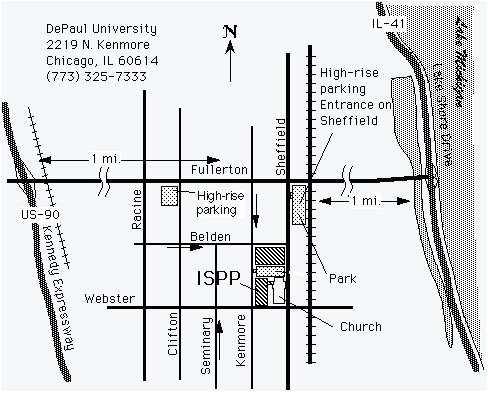OUR
NEXT MEETING...
...is at De Paul University
Tuesday
December 5, 2006
6:30 - 9:00 PM
Click here
for directions and a map.
FUTURE MEETINGS...
| Jan 17 (Wed) |
Elmhurst College |
Earl Swallow |
| Feb 13 (Tue) |
Northeastern Illinois University |
Paul Dolan/Joe Hermanek |
| Mar 7 (Wed) |
Chicago State University |
Mel Sabella |
| Apr 3 (Tue) |
Lake Forest College |
Mike Kash/Bailey Donnally |
| May 7 (Mon) |
Northwestern University |
Art Schmidt |
| June 5 or 12 (tentative) |
Columbia College or Museum of
Science and Industry |
|
BRIDGE
CONTEST NEWS High |
AT OUR LAST MEETING . . .
We were greeted at Oak Park and River Forest High School by Kevin McCarron, and two new teachers were introduced. Norman Hodgson and Rich DeThorne (who will start student teaching in a couple of weeks). They received New Teacher Bags.
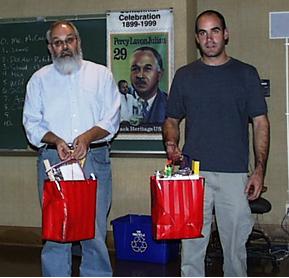 |
We were greeted
at Oak Park and River Forest High School by Kevin McCarron, and two
new teachers were
introduced. Norman Hodgson and
Rich
DeThorne (who will start student teaching in a couple of weeks). t the end of the meeting they received New
Teacher Bags from Debby Lojkutz. Kevin started out the meeting with
his Play-Doh. He rubbed out a couple
cylinders and attached
them to 3V and a milliammeter. The
longer roll measured 4ma and the shorter roll 7ma.
Then he made a short fat roll that pinned the
meter at 10mA. Kevin is using Play-Doh to investigate the effects of
length and
area on resistance. John
Milton ( |
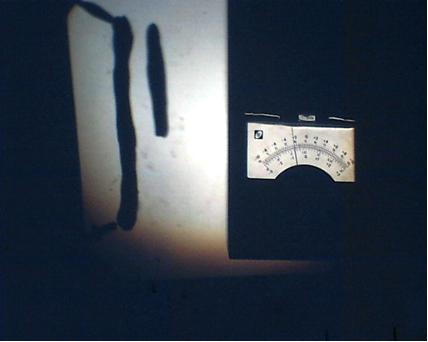 |
|
Jamie Chichester ( |
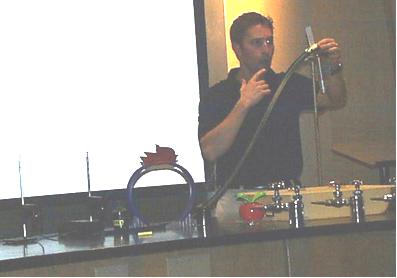 |
Paul Dolan (
|
Art Schmidt (
|
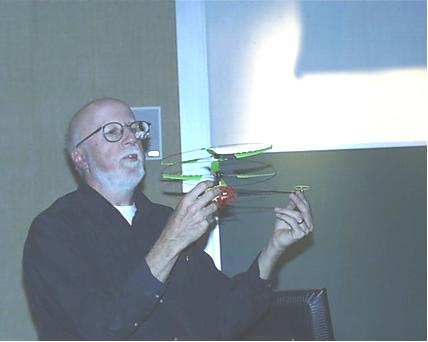 |
Max Lee (
Eileen Wild (CPS, retired) got out her trusty overhead projector and put on a transparency that said the equation that the flight of a butterfly is PR = S2/A.
R is the Reynolds number and A the area. I think P is pressure and S the speed of the wing but I’m not sure. We didn’t discuss it.
Eileen also balanced a saltshaker in a little pile of salt. When you blow the salt away the saltshaker is supposed to stay balanced. I guess you need to do it more slowly and carefully than we did. Everyone agreed the few grains left after blowing provided enough of a base to balance the saltshaker.
Aaron Podolner (Oak Park and River Forest High School) videotaped a dancer doing a leap to show her center of mass moved in a parabola even though it looked like she simply floated. Aaron pointed out the movement of her stomach during the leap and then pointed out the movement of her head. He was looking for the parabolic motion that must be the motion of her center of mass. You can look at assorted videos at apodolner@oprfhs.org. |
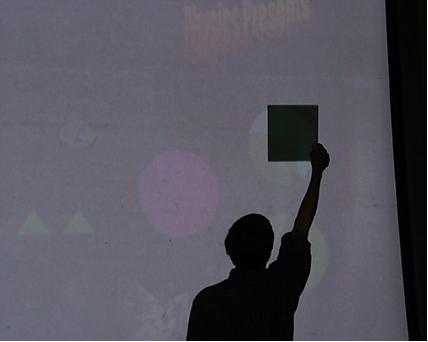 |
| Carl
Spight (Oak Park and River Forest High School) brought a thumb
piano or kalimba that he played for us. It has a wooden body
about the size of a large grapefruit and eight metal tines that are
tuned to the white keys of a piano. These tines are fixed at the
base and vibrated with the thumb. Their lengths vary to give
different pitches with the octave having a length ratio of 21/2
instead of 2, as there would be with strings fixed at both ends. Carl was also interested in “magnetic fluids” but no one had any information for him. Thanks OPRFHS teachers for a very nice meeting! See you December 5 at DePaul University. |
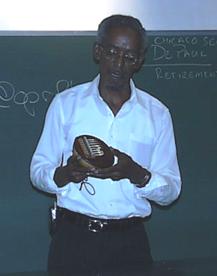 |
Submitted by Pete Insley.
For any information regarding ISPP contact Gerry Lietz at DePaul University, Physics Department, 2219 N. Kenmore Chi. IL 60614 phone:
BRING FRIENDS
BRING IDEAS ! !
| ↓ THESE POSITIONS ↓ NEED TO BE UPGRADED. LET’S DO THIS AT THE DE PAUL MEETING |
Coordinators:
ISPP Authors: Art Schmidt Data Base Managers:
John Milton
Pete Insley
Photographers: Paul Dolan Treasurers:
Art Schmidt
Gerry Lietz
John Milton
Earl Zwicker
Special Events Committees:
Physics Day –
John Rush Award –
Harald Jensen Award –
Annual Tri-Physics Meeting –
National Bridge Building Committee –
New Member Committee –
From the north
and northwest
From the Kennedy Expressway (I-90/I-94) exit at Fullerton Avenue and
turn left (east.) The Lincoln Park campus is
approximately two mile from the expressway on Fullerton Avenue at
Kenmore Avenue.
From the
west
From the Eisenhower Expressway (I-290), turn onto
the Kennedy Expressway (I-90/I-94) heading toward Wisconsin. From the
Kennedy Expressway (I-90/I-94) exit at Fullerton Avenue and turn right
(east.). The Lincoln Park campus is approximately two miles from the
expressway on Fullerton Avenue at Kenmore Avenue.
From the
south
From the Dan Ryan Expressway (I-90/I-94) continue as the expressway
becomes the Kennedy Expressway (I-90/I-94). Exit at Fullerton Avenue
and turn right (east.) The Lincoln Park campus is approximately two
miles from the expressway on Fullerton Avenue at Kenmore Avenue.
From Lake
Shore Drive (north or south)
Exit Lake Shore Drive at Fullerton Avenue. Head west for approximately
three miles. The Lincoln Park campus is located at
Fullerton Avenue at Kenmore Avenue.
|
If you use the Sheffield Avenue
high-rise
parking structure, get a chit at the meeting that will cover the cost. |
